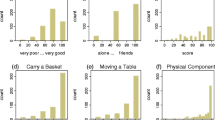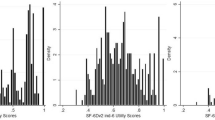Abstract
To compare two modes of administration (self-administered; by interviewer) and two response options format (using words; images of “facial-expressions”) of the first question of SF-36 (Q1SF-36), and to test its validity. We included 825 participants (20–90 years). Q1SF-36, using words or images, was included in a global questionnaire interview and at the end participants filled the SF-36. The agreement was tested by weighted kappa coefficients (WKappa). Classification Trees were used in the calibration of Q1SF-36 responses, with the physical (PDSF36) and mental dimensions of SF-36. Polyserial correlation coefficients and areas under the ROC curves (AUC) were used for validation. After categorization, using PDSF36 classification trees, the WKappa were 0.770 (self-administered vs. interviewer), 0.569 (self-administered vs. facial-expressions) and 0.566 (interviewer vs. facial-expressions). The WKappa between the PDSF36 and the modes (self-administered, interviewer and facial-expressions) were 0.784, 0.713 and 0.579 and the corresponding polyserial correlation coefficients were 0.784, 0.713 and 0.579. A good discriminatory power was found comparing the modes with the PDSF36 (AUC = 0.907, 0.923 and 0.827), but not with mental dimension (AUC = 0.538, 0.501 and 0.629). The Q1SF-36, by self-administration or interviewer, may be a valid alternative for assessment of subjective physical health, but not mental health.


Similar content being viewed by others
References
Beck, A., Ward, C., Mendelson, M., et al. (1961). An inventory for measuring depression. Archives of General Psychiatry, 4, 561–571.
Bergamasco, N. H. P. (1997). Facial expression as an acces to newborns consciousness. Psicologia, USP, 8(2), 275–286.
Bierman, A. S., Bubolz, T. A., Fisher, E. S., & Wasson, J. H. (1999). How well does a single question about health predict the financial health of Medicare managed care plans? Effective Clinical Practice, 2(2), 56–62.
Boer, A. G., Lanschot, J. J., Stalmeier, P. F., Sandick, J. W., Hulscher, J. B., Haes, J. C., et al. (2004). Is a single-item visual analogue scale as valid, reliable and responsive as multi-item scales in measuring quality of life? Quality of Life Research, 13(2), 311–320.
Bowling, A. (2005a). Just one question: If one question works, why ask several? Journal of Epidemiology and Community Health, 59(5), 342–345.
Bowling, A. (2005b). Mode of questionnaire administration can have serious effects on data quality. Journal of Public Health, 27(3), 281–291.
Bowling, A., Bond, M., Jenkinson, C., & Lamping, D. L. (1999). Short form 36 (SF-36) health survey questionnaire: Which normative data should be used? Comparisons between the norms provided by the Omnibus Survey in Britain, the Health Survey for England and the Oxford healthy life survey. Journal of Public Health Medicine, 21(3), 255–270.
Breiman, L., Friedman, J., Olshen, R., & Stone, C. J. (1984). Classification and regression trees. California: Wadsworth.
Carvalho, D. S., & Kowacs, P. A. (2006). Avaliação da intensidade de dor. Migrâneas cafaléias, 9(4), 164–168.
DeSalvo, K. B., Fan, V. S., McDonell, M. B., & Fihn, S. D. (2005). Predicting mortality and healthcare utilization with a single question. Health Services Research, 40(4), 1234–1246.
Erhart, M., Wetzel, R., Krügel, A., & Ravens-Sieberer, U. (2005). Assessment of health-related quality of life with the German SF-8. A comparison of telephone and postal survey modes. Bundesgesundheitsblatt Gesundheitsforschung Gesundheitsschutz, 48(12), 1322–1329.
Ferreira, P. (2000a). Criação da Versão Portuguesa do MOS SF-36. Parte I: Adaptação Cultural e Linguística. Acta Médica Portuguesa, 13, 55–66.
Ferreira, P. (2000b). Criação da versão portuguesa do MOS SF-36. Parte II: Testes de validação. Acta Médica Portuguesa, 13, 119–127.
Ferreira, L. N. (2003). Utilidades, QALYs e medição da qualidade de vida. Revista Portuguesa de Saúde Pública, 3, 51–63.
Garcia-Losa, M., Unda, M., Badia, X., Rodriguez-Alcantara, E., Carballido, J., & Dal-Re, R. (2001). Effect of mode of administration on I-PSS scores in a large BHP patient population. European Urology, 40, 451–457.
Górna, K., Jaracz, K., Rybakowski, F., & Rybakowski, J. (2008). Determinants of objective and subjective quality of life in first-time-admission schizophrenic patients in Poland: A longitudinal study. Quality of Life Research, 17(2), 237–247.
Grégoire, M. C., & Finley, A. G. (2008). “Doctor, I think my baby is in pain”: The assessment of infants’ pain by health professionals. Jornal de Pediatria, 84, 6–8.
Guyatt, G. H., Feeny, D. H., & Patrick, D. L. (1993). Measuring health-related quality of life. Annals of Internal Medicine, 118, 622–629.
Hanmer, J., Hays, R. D., & Fryback, D. G. (2007). Mode of administration is important in US national estimates of health-related quality of life. Medical Care, 45(12), 1171–1179.
Hartge, P., Brinton, L. A., Rosenthal, J. F., Cahill, J. I., Hoover, R. N., & Waksberg, J. (1984). Randon digit dialing in selecting a population-based control group. American Journal of Epidemiology, 120, 825–833.
Hicks, C. L., Von Baeyer, C. L., Spafford, P. A., Van Korlaar, I., & Goodenough, B. (2001). The faces pain scale-revised: Toward a common metric in pediatric pain measurement. Pain, 93, 173–183.
Johansson, P., Broström, A., Dahlström, U., & Alehagen, U. (2008). Global perceived health and health-related quality of life in elderly primary care patients with symptoms of heart failure. European Journal of Cardiovascular Nursing, 7(4), 269–276.
Lyons, R. A., Wareham, K., Lucas, M., Price, D., Williams, J., & Hutchings, H. A. (1999). SF-36 scores vary by method of administration: Implications for study design. Journal of Public Health Medicine, 21(1), 41–45.
Maisto, S. A., Conigliaro, J. C., Gordon, A. J., McGinnis, K. A., & Justice, A. C. (2008). An experimental study of the agreement of self-administration and telephone administration of the timeline followback interview. Journal of Studies on Alcohol Drugs, 69(3), 468–471.
McDowell, I., & Newell, C. (1996). Measuring health: A guide to rating scales and questionnaires. New York: Oxford University Press.
McHorney, C. A., Kosinski, M., & Ware, J. E. (1994). Comparisons of the costs and quality of norms for the SF-36 health survey collected by mail versus telephone interview: Results from a national survey. Medical Care, 32, 551–557.
Miller, D. R., Clark, J. A., Rogers, W. H., Skinner, K. M., Spiro, A., & Lee, A. (2005). The influence of place of administration on health-related quality-of-life assessments. Journal of Ambulatory Care Management, 28(2), 111–124.
Murray, C. J. L., Salomon, J. A., Mathers, C. D., & Lopez, A. D. (2002). Summary measures of population health: Concepts, ethics, measurement and applications. Geneva: World Health Organization.
Nguyen, H. Q., Donesky-Cuenco, D., & Carrieri-Kohlman, V. (2008). Associations between symptoms, functioning, and perceptions of mastery with global self-rated health in patients with COPD: A cross-sectional study. International Journal of Nursing Studies, 45(9), 1355–1365.
O’Toole, B. I., Battistutta, D., Long, A., & Crouch, K. (1986). A comparison of costs and data quality of three health survey methods: Mail, telephone and personal home interview. American Journal of Epidemiology, 124(3), 317–328.
Okamoto, K., Ohsuka, K., Shiraishi, T., Hukazawa, E., Wakasugi, S., & Furuta, K. (2002). Comparability of epidemiological information between self- and interviewer-administered questionnaires. Journal of Clinical Epidemiology, 55(5), 505–511.
Presser, S., & Stinson, L. (1998). Data collection mode and social desirability bias in self-reported religious attendence. American Sociological Review, 63, 137–145.
Ramos, E., Lopes, C., & Barros, H. (2004). Investigating the effect of nonparticipation using a population-based case-control study on miocardial infaction. Annals of Epidemiology, 14, 437–441.
Sen, A. (2002). Health: Perception versus observation. BMJ, 324, 860–861.
Severo, M., Santos, A. C., Lopes, C., & Barros, H. (2006). Fiabilidade e Validade dos Conceitos Teóricos das Dimensões de Saúde Física e Mental da Versão Portuguesa do MOS SF-36*. Acta Medica Portuguesa, 19, 281–288.
Thompson, D. R., & Yu, C. M. (2003). Quality of life in patients with coronary heart desease-I: Assessement tools. Health Qual Life Outcomes, 10(1), 42.
Tsakos, G., Bernabé, E., O’Brien, K., Sheiham, A., & Oliveira, C. (2008). Comparison of the self-administered and interviewer-administered modes of the child-OIDP. Health Quality Life Outcomes, 6, 40–41.
Varni, J. W., Limbers, C. A., & Newman, D. A. (2009). Using factor analysis to confirm the validity of children’s self-reported health-related quality of life across different modes of administration. Clinical Trials, 6(2), 185–195.
Voepel-Lewis, T., Malviya, S., & Tait, A. R. (2005). Validity of parent ratings as proxy measures of pain in children with cognitive impairment. Pain Management Nursing, 6, 168–174.
Weinberger, M., Oddone, E. Z., Samsa, G. P., & Landsman, P. B. (1996). Are health-related quality-of-life measures affected by the mode of administration? Journal of Clinical Epidemiology, 49, 135–140.
WHO (1994). The development of the World Health Organization quality of life assessment instrument (the WHOQOL) (pp. 41–60). Heidelberg: Springer Verlag.
Author information
Authors and Affiliations
Corresponding author
Rights and permissions
About this article
Cite this article
Mendes, S., Severo, M. & Lopes, C. Comparison of Modes of Administration and Response Options in the Assessment of Subjective Health Using the First Question of SF-36. Soc Indic Res 107, 305–315 (2012). https://doi.org/10.1007/s11205-011-9849-y
Accepted:
Published:
Issue Date:
DOI: https://doi.org/10.1007/s11205-011-9849-y




